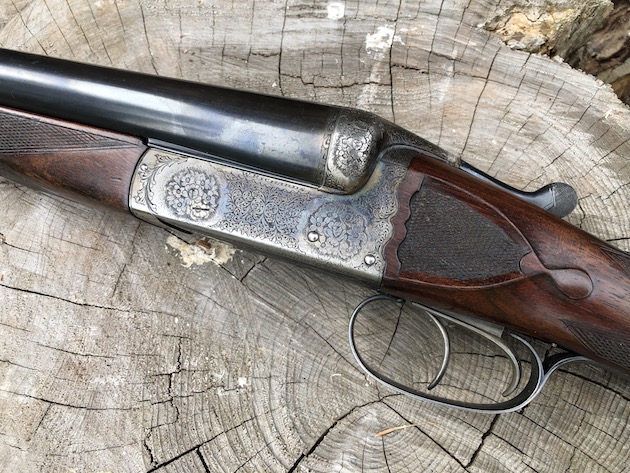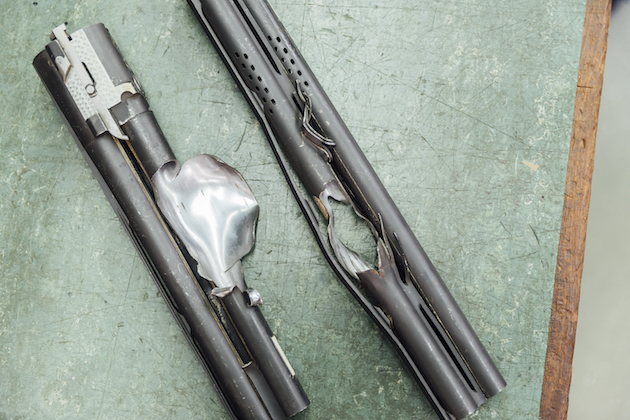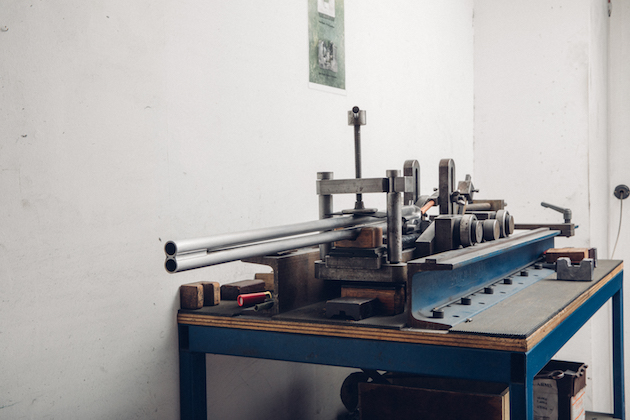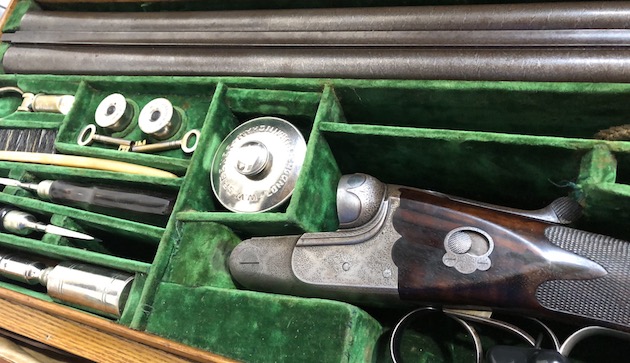Testing steel vs lead shot on pigeon
British shooting has been divided in recent months by the announcement on the withdrawal of lead shot within five years.…
Win CENS ProFlex DX5 earplugs worth £1,149 – enter here
 CAPTION: This W. Richards is heavy, at 7lbs 6oz, has 3” chambers and wall thicknesses of 34 thou’ minimum. The bores measure. 729”, as new. This would be a good candidate for using standard steel shot, or even adapting for superior steel’ and submitting for steel shot re-proof. To do so, the Full choke in the left barrel needs to be reduced to Half, the forcing cones cold be ‘eased’ and the choke cones likewise, to ensure smooth passage for the steel shot.
Usd 25 march 20 buy english
CAPTION: This W. Richards is heavy, at 7lbs 6oz, has 3” chambers and wall thicknesses of 34 thou’ minimum. The bores measure. 729”, as new. This would be a good candidate for using standard steel shot, or even adapting for superior steel’ and submitting for steel shot re-proof. To do so, the Full choke in the left barrel needs to be reduced to Half, the forcing cones cold be ‘eased’ and the choke cones likewise, to ensure smooth passage for the steel shot.
Usd 25 march 20 buy english
If you are anticipating a drop in the price of English guns in the wake of the announcement that lead shot should be phased out over the next five years, and are considering taking advantage of the situation, there are some considerations you need to mull over before parting with your money. The first, of course, is the ammunition you’re going to use.
The advice coming from the authorities at the moment is, frankly, unsupported by data and is over-simplistic in delivery. The latest missive from the Gun Trade Association and the Proof Houses is that you can shoot standard steel loads in your 2 ¾in nitro-proofed British gun. Hopefully, you will note the caveat to do so only in guns with 2 ¾in chambers, good wall thickness and in good condition.
Suitability for various types of ammunition has always been gauged via proof testing. Now it seems we are skipping a test and being told standard steel is fine in guns proof tested with lead. That is not proof, it is assumption.
What is meant by “good condition”? What constitutes “good wall thickness”? What of other factors? This is all troublingly imprecise. One barrel maker I spoke to last week told me he had seen many older guns damaged by steel shot, with rivels, bulges and scoring of the bores common.
English gun enthusiasts may soon find that they can buy a lot more for their money
The smooth passage of steel shot through a barrel is made possible by a skilled barrel maker working with all his knowledge to avoid the many pitfalls that may be inherent in older barrels made and proofed for lead shot.
Starting with the chamber, it needs to hold the pressure generated by the burning powder trying to propel the steel at sufficient speed to compensate for its lighter weight.
That requires a good quality steel of sufficient toughness to withstand the expansion. The pressure wave will differ from that produced by the lead-loaded cartridges for which the gun was proof tested. This, in turn, puts more pressure on the face and action of the gun. This is why we see some guns crack at the radius — the angle between face and bar — at re-proof.

Putting steel through barrels that have not been proofed for it can endanger both you and your gun
Next is the forcing cone, which leads the shot column, in its closed-cup wad, from the chamber into the bore. A modern, steel shot-proofed 12-bore gun will have barrels made to .728in (18.5mm) in the bore. Many older guns can be much tighter — .710in is not uncommon. Steel is much less “fluid” in its movement than lead because it is harder. This additional compression will put further stress on the barrel walls.
Most older guns, and often an English classic gun, will have had the barrels lapped-out to remove pitting. They may still have some pitting, they may have dents or bulges and they may no longer be concentric. These factors could be material in affecting the safe passage of the shot. If it has been proof tested with lead, its reaction to steel loads remains unproven. Many gun owners do not possess the training or observational ability to spot and evaluate these factors.

A gun’s suitability for various types of ammunition has always been gauged via proof testing
Once moving down the bore, the shot column may encounter some other hurdles. Many older guns originally had no choke — it wasn’t popularised until 1875. This is a good thing, as a cylinder muzzle will not obstruct the passage of the ejecta. However, some guns were recessed choked, providing a wider section behind the muzzle to allow the shot charge to widen, before again being constricted at the muzzle. This provides a disruption to the flow of the charge. If this back-boring has been done retrospectively, it will also have thinned the tubes in that section.
New steel shot barrels generally have wall thicknesses of more than 30 thou minimum. Many older guns have much thinner walls due to the removal of pitting in the past.
They may have thin spots, where a dent or a bulge has been removed. These are weak spots. To find them you need a wall thickness gauge and the experience to use it.
If the muzzle is choked, the shot begins to leave the wad behind at the choked section. This allows the hard steel shot to scrape the soft steel barrels and score them. The angle of the choke cone is important too. If it is steep, it will compress the shot column too fast and the result could be a bulge.
The advice is not to shoot steel through chokes tighter than half. How do you determine that? A choke gauge is useless. All that tells you is the muzzle diameter. The true measurement is the difference between the muzzle diameter and that of the bore behind the choke cone. You need a bore gauge to measure that and do the calculation. How many people own a bore gauge?

For this Greener Facile Princeps, the only possible lead alternative is bismuth
There are simply too many factors here that are unproven in most of the old guns in use. Despite the assurances that you can shoot “standard steel” loads in your guns — as long as they are 2¾in chambered and nitro-proofed — I advise owners of British guns not to do so. There are simply too many unknown factors that could damage your gun or endanger you.
At the very least, get the gun to a qualified and experienced expert — ideally a barrel maker — to have the barrels measured and assessed before you even consider putting steel shot through them. In the meantime, your off-the-shelf alternative is bismuth. It may be more expensive but it is the best, safest alternative to lead now on the market.
We have, however, five years to shoot lead as much as we like and are simply being encouraged to experiment with alternatives, while the cartridge makers develop better non-toxic game loads.
If, like me, you are an enthusiast for an English classic gun, you may be thinking that the odious Mr Rees-Mogg’s advice from his father that you can make money from any disaster could indicate an advantageous situation on your horizon. More simply, as a client put it to me, “the guns I like buying could become cheaper”.
The market may react negatively to the lead phase-out. Some will probably decide that there will be a lead shot ban in five years, so now is the time to get rid of the old guns. If they do, and a lot of guns hit the market at once, there may be an opportunity to buy something nice for not a great deal of money. So should you buy one?
One auctioneer told me that the price of English guns was already historically low and he couldn’t see much scope for further falls. Auctions can give us an indication of early market reaction, though it is hard to tell what effect the coronavirus might have. We must also remember that many buyers bidding in British auctions are not British.
Americans and Russians will not be fazed by the situation in the UK and if nice guns are going cheap, they will be happy to buy them. We have seen the auctions hold up well in the past to currency fluctuations and when one market weakens another one generally steps in to shore up prices.
What are the risks if you do decide to buy a British gun? Let us imagine that prices in the next 12 months drop by 30%. That £15,000 Purdey you always wanted but couldn’t justify is now just over £10,000. If you have to shoot bismuth through it eventually, the saving you made will buy you 5,000 bismuth cartridges.
Assuming you shoot 10 200-bird days a season, firing an average of 100 shots per day, you have enough ammo there for five seasons of shooting before you move above break even. If you account for the cost of the lead you would have used, you have another £1,750 in the kitty, buying you another two seasons of bismuth. So if you are 50, you can shoot until you are 62 without having to pay anything extra, simply based on the saving you made when you bought the gun.
As the proposals stand, we will still have lead to shoot at clay grounds; it is only game shoots that will require the use of non-toxic shot. If you can’t see yourself paying £1 a shot for bismuth and you want to explore steel shot alternatives, you need to look at a very clean English classic gun with 2¾in chambers or have your gun adjusted and re-proofed to handle standard steel loads.
There is still a collector’s market for obsolete firearms, so don’t expect the value of Best guns to collapse. As always, look for the highest quality in the best original condition. Do not buy an English classic gun as an“investment”. Buy them because you love them and appreciate the privilege of shooting them. That being the case, accept that they cost a little more in money and effort to keep them in the line and adjust your shooting budget accordingly.
British shooting has been divided in recent months by the announcement on the withdrawal of lead shot within five years.…
I would like to try steel shot for wildfowling in my 2.5in chambered gun, but I have been told by…
The situation, however, is not yet certain. When leaded petrol was banned in 2000, an exemption for classic vehicles allowed 0.5% of petrol sales to be leaded four-star, sold through accredited classic vehicle clubs. The tiny amount of lead emitted by the few vehicles still using it became essentially irrelevant. The same argument can be made for classic English shotguns. If a lead phase-out achieves a 95% reduction and only users of pre-World War II English guns continue to use lead shot, the problem will be so small as to be unworthy of further restriction.
Is this a good time to buy an English classic gun? It could be. We might begin to see some new-to-market heirlooms making themselves available.
Get the latest news delivered direct to your door
Discover the ultimate companion for field sports enthusiasts with Shooting Times & Country Magazine, the UK’s leading weekly publication that has been at the forefront of shooting culture since 1882. Subscribers gain access to expert tips, comprehensive gear reviews, seasonal advice and a vibrant community of like-minded shooters.
Save on shop price when you subscribe with weekly issues featuring in-depth articles on gundog training, exclusive member offers and access to the digital back issue library. A Shooting Times & Country subscription is more than a magazine, don’t just read about the countryside; immerse yourself in its most authoritative and engaging publication.

